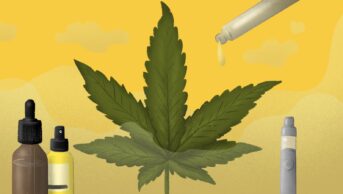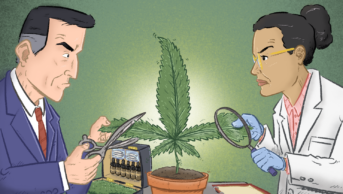
Charlie Milligan
The Advisory Council on the Misuse of Drugs (ACMD) has been asked to provide an outline framework on medical cannabis by the end of 2019, with the aim of having an initial view by the end of 2020.
Roger Knaggs, specialist pharmacist in pain management and recent appointee to the ACMD, which is responsible for advising the government on the control of dangerous or otherwise harmful drugs, told The Pharmaceutical Journal
that cannabis was “definitely” going to occupy a lot of the ACMD’s time “for a whole host of reasons”.
During the interview, Knaggs highlighted that when it comes to “cannabis-based products for medicinal use” and pain, “the evidence for benefit is very small but the evidence for … more serious harms, is significantly higher”.
“If you look at the number needed to treat, you need to treat between 20 to 25 people for 1 person to have good pain relief, but you only need to treat 6 patients for 1 to experience harm,” he explained, adding that there was a need for “better data” and a more thorough understanding of cannabinoid pharmacology.
He expressed his concerns that although initiatives in different countries had looked at the increasing availability of cannabis for medical purposes, each country’s approach had been slightly different and, consequently, we are “living in the middle of a social experiment”.
“Nowhere, so far, has really evaluated what the impact of these changes to classification and availability have had,” he said, adding that, from a prescribing perspective, a “big question” still remained around dose.
“We just don’t know what the right dose is, and, also, what the right combination of these compounds is for an individual person — what would you write the prescription for?”
Knaggs added that he was not surprised by the lack of prescriptions for medical cannabis since its reclassification in November 2018, and that it was likely this would remain the case until prescribers have access to more evidence and information about what they should prescribe.
“Prescribers who wish to prescribe [medical cannabis] just don’t know which the right product is for that person and until there are products that are more familiar, the situation may well still remain.
“Aside from all of the issues around cost — because these are not cheap products — if you look at some of the products that are available in other countries, even though they claim they are manufactured to [good manufacturing practice] standards, they should be more reproducible in terms of their composition.
“The way in which they are packaged and supplied at the moment is unhelpful for prescribers.”
The National Institute for Health and Care Excellence is due to publish guidance on medical cannabis in October 2019.
Knaggs also drew attention to the recent opening of private cannabis clinics, which he said create other issues, such as equity.
“A couple of weeks ago, the person who had the first cannabis prescription decided that they had exhausted their savings and was openly going to grow their own illegally because they couldn’t continue to afford the private prescriptions.
“There are so many issues that this is creating.”


